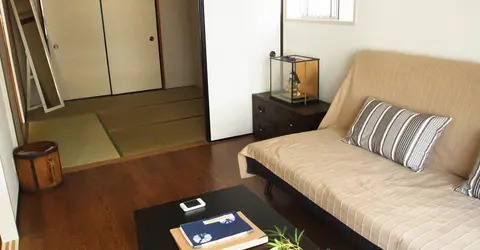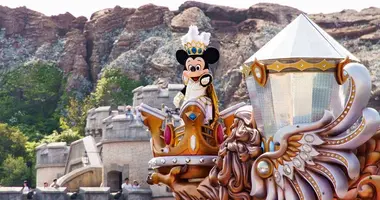Shosenkyo Gorge: A natural wonder in the heart of Japan
- Published on : 24/07/2024
- by : Japan Experience
- Youtube
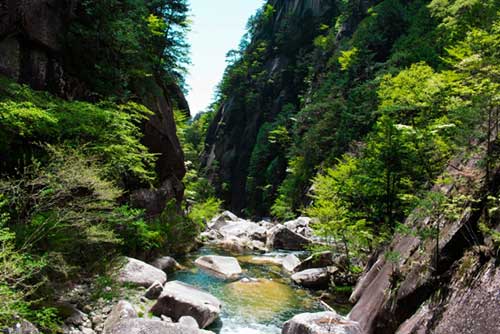
Nestled in the mountains of Yamanashi Prefecture, Shosenkyo Gorge stands as a testament to Japan's breathtaking natural beauty. This scenic wonder, part of the expansive Chichibu-Tama-Kai National Park, offers visitors a chance to immerse themselves in pristine landscapes, from towering cliffs to crystal-clear rivers. As you venture through this 4-kilometer stretch of natural splendor, you'll discover why Shosenkyo is often hailed as one of Japan's most beautiful gorges. Whether you're an avid hiker, a nature enthusiast, or simply seeking a peaceful escape from urban life, Shosenkyo Gorge promises an unforgettable journey through the heart of Japan's wilderness. Join us as we explore the wonders of this natural gem, from its unique rock formations to its seasonal transformations, and uncover the secrets that make Shosenkyo a must-visit destination for travelers from around the world.
What is Shosenkyo Gorge and where is it located?
Shosenkyo Gorge, known in Japanese as Mitake Shosenkyo (御嶽昇仙峡), is a stunning natural formation located just north of Kofu city in Yamanashi Prefecture. This picturesque gorge is part of the larger Chichibu-Tama-Kai National Park, which spans over 1,250 square kilometers across Yamanashi, Saitama, Nagano, and Tokyo prefectures. The gorge itself stretches for about 4 kilometers along the Arakawa River, carved out over millennia by the relentless flow of water through granite mountains.
What sets Shosenkyo apart is its unique combination of natural features. As you walk through the gorge, you'll be surrounded by towering granite cliffs, some reaching heights of up to 180 meters. These cliffs, sculpted by wind and water, create a dramatic backdrop for the crystal-clear river flowing below. The most iconic of these rock formations is Kakuenpo, a striking granite monolith that serves as the symbol of Shosenkyo Gorge.
The area is not just about rocks and water, though. Lush forests blanket the surrounding mountains, creating a vibrant ecosystem that changes with the seasons. This diversity of landscapes within a relatively compact area is what makes Shosenkyo Gorge a microcosm of Japan's natural beauty. Have you ever wondered what it would be like to walk through a landscape that seems to embody the essence of traditional Japanese paintings? Shosenkyo offers precisely that experience.
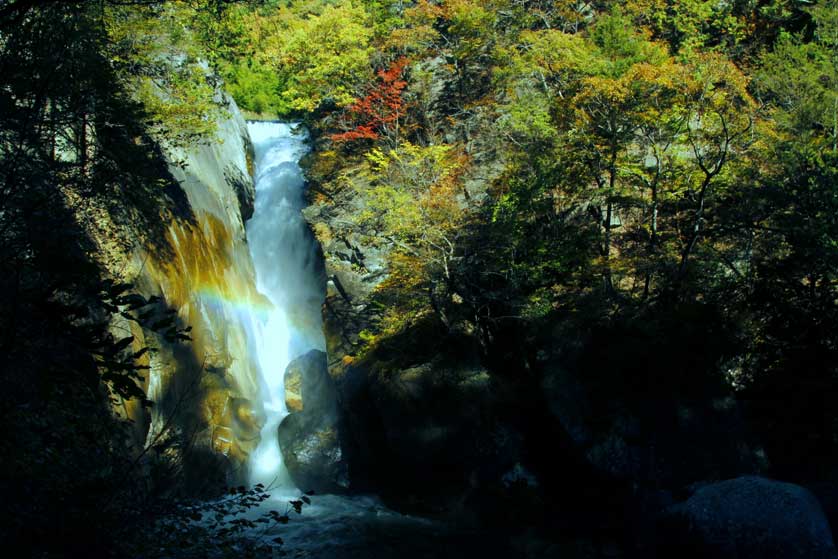
Exploring the hiking trails: From Nagatoro Bridge to Sengataki Waterfall
The heart of the Shosenkyo Gorge experience lies in its hiking trails, offering an intimate journey through this natural wonder. The main trail stretches from the Nagatoro Bridge to the Sengataki Waterfall, a distance of about 4 kilometers that typically takes around 90 minutes to two hours to complete, depending on your pace and how often you stop to admire the scenery.
Your adventure begins at the Nagatoro Bridge, a picturesque starting point that offers your first glimpse of the Arakawa River flowing beneath. As you set off, you'll find yourself on a well-maintained path that follows the river's course. The first section of the trail is relatively easy, with a paved road that's suitable for most fitness levels. This part of the gorge is open to one-way vehicular traffic, except on weekends from May to November when it's reserved for pedestrians and the occasional horse-drawn carriage.
As you progress deeper into the gorge, the scenery becomes increasingly dramatic. You'll pass by the Tenkorin Forest, a serene area where the path is flanked by towering trees, creating a cool, shaded respite. About halfway through your hike, you'll reach the Rakanji Bridge, another scenic spot that offers breathtaking views of the gorge and the river below.
The latter part of the trail becomes more challenging but also more rewarding. As you approach the Sengataki Waterfall, the path narrows and steepens slightly. This final kilometer is where you'll encounter some of the most spectacular views of the gorge, including the famous Ishimon, a natural stone gate formation.
Your hike culminates at the Sengataki Waterfall, a 30-meter high cascade that serves as the dramatic finale to your journey. The sight and sound of the water plunging into the turquoise pool below is truly awe-inspiring, especially when framed by the autumn colors or winter snow.
Throughout your hike, you'll find various viewpoints and rest areas where you can pause to catch your breath and soak in the scenery. How many hidden corners and breathtaking vistas will you discover along the way? Each turn of the path offers a new perspective on the gorge's beauty, making every step of the journey an adventure in itself.
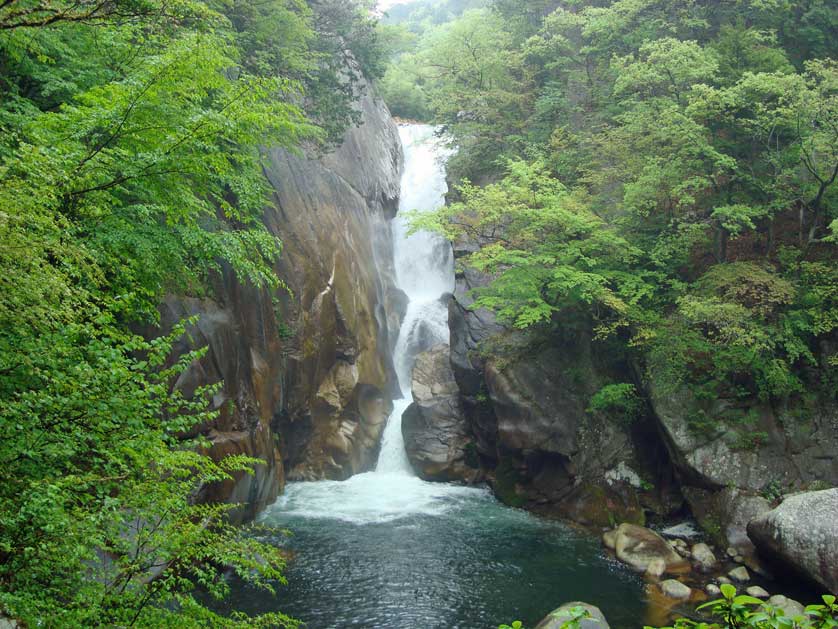
Natural wonders and unique rock formations along the gorge
Shosenkyo Gorge is renowned for its spectacular rock formations that have been sculpted by nature over millions of years. These unique geological features not only add to the scenic beauty of the gorge but also spark the imagination, with many rocks resembling familiar shapes and creatures.
One of the most impressive formations is Kakuenpo, a towering granite monolith that stands about 180 meters high. This massive rock face is not only a symbol of Shosenkyo but also a testament to the raw power of nature. It's said that a Buddhist monk named Kakuen once practiced meditation atop this precarious perch, giving the formation its name.
As you traverse the gorge, you'll encounter the Ishimon, or "Stone Gate." This natural archway is formed by two large boulders that seem to balance precariously above the path. Walking through this formation is like passing through a portal to another world, heightening the sense of adventure as you explore deeper into the gorge.
Along the river, you'll spot rocks with intriguing shapes that have earned them colorful nicknames. Look out for Monkey Rock (Saru-ishi), which, true to its name, resembles a simian figure perched by the water's edge. There's also Turtle Rock (Kame-ishi) and Cannonball Rock (Tama-ishi), each adding a touch of whimsy to the landscape.
One of the most photographed spots in the gorge is Yume no Matsushima, or "Dream Matsushima." This area features a cluster of oddly shaped rocks jutting out from the riverbank, reminiscent of the famous pine-clad islands of Matsushima Bay in Miyagi Prefecture.
As you near the end of the trail, you'll come across the Sengataki Waterfall, where water cascades dramatically over a 30-meter high cliff. The waterfall isn't just a visual spectacle; the sound of rushing water provides a soothing natural soundtrack to your journey.
These rock formations aren't just scenic attractions; they're also windows into the geological history of the area. The granite that forms much of Shosenkyo Gorge was created deep underground millions of years ago and gradually exposed by erosion. Can you imagine the forces of nature that shaped these rocks over countless millennia? Each formation tells a story of patience and persistence, of water and wind slowly carving away at solid stone to create the masterpiece we see today.
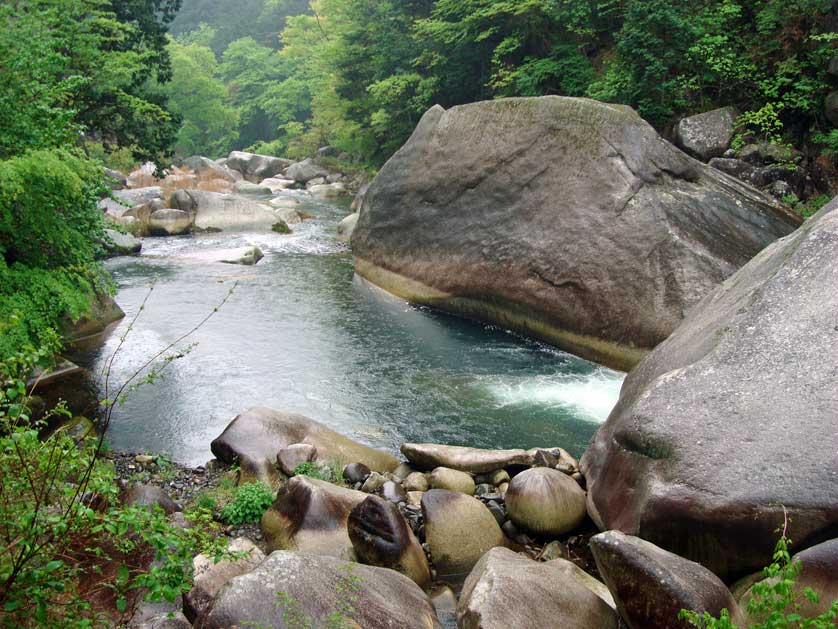
Seasonal beauty: Experiencing Shosenkyo throughout the year
Shosenkyo Gorge is a year-round destination, with each season offering a unique perspective on its natural beauty. The changing faces of the gorge throughout the year provide visitors with diverse experiences, making it worth visiting more than once to fully appreciate its seasonal transformations.
Spring brings a sense of renewal to Shosenkyo. As the snow melts and temperatures rise, the gorge comes alive with fresh greenery. Cherry blossoms and other spring flowers add splashes of color to the landscape. The increased water flow from melting snow makes this an excellent time to appreciate the power of the Arakawa River and the Sengataki Waterfall. The mild weather also makes it ideal for hiking and exploring the trails.
In summer, Shosenkyo offers a cool retreat from the heat. The dense foliage provides ample shade, and the river's clear, cool waters are particularly refreshing. This is a great time for activities like river trekking or simply enjoying a picnic by the water's edge. The lush greenery creates a vibrant backdrop for the gray granite cliffs, offering stunning contrasts for photography enthusiasts.
Autumn is perhaps the most popular season to visit Shosenkyo, and for good reason. The gorge transforms into a spectacular display of fall colors, typically reaching its peak in early to mid-November. The vibrant reds, oranges, and golds of the changing leaves create a stunning contrast against the stark granite cliffs and the clear blue sky. This season offers some of the most photogenic views of the gorge, with the colorful foliage reflected in the calm sections of the river.
Winter brings a different kind of beauty to Shosenkyo. While some trails may be closed due to snow and ice, the gorge takes on a serene, almost mystical atmosphere. The bare trees reveal rock formations that might be hidden in other seasons, and on clear days, the snow-capped peaks of the surrounding mountains create a breathtaking backdrop. The Sengataki Waterfall partially freezes, creating unique ice formations that change daily.
Regardless of when you visit, each season in Shosenkyo offers its own charm and challenges. Which season do you think would offer the most memorable experience for you? Whether it's the fresh renewal of spring, the lush vibrancy of summer, the fiery colors of autumn, or the quiet solitude of winter, Shosenkyo Gorge never fails to impress with its natural beauty.
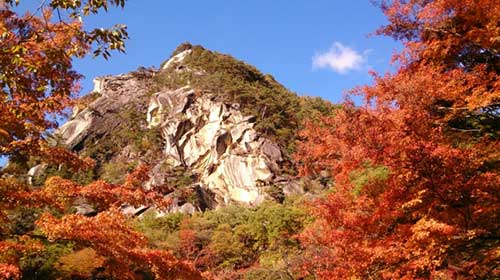
Shosenkyo Ropeway and panoramic views
For those seeking a different perspective on Shosenkyo Gorge, the Shosenkyo Ropeway offers an exhilarating aerial experience. This cable car system, located near the Sengataki Waterfall at the northern end of the gorge, whisks visitors up to the observation point on Mt. Rakanji in just five minutes.
The ropeway journey itself is a thrilling experience. As you ascend, you'll glide over the treetops, gaining a bird's-eye view of the gorge below. The gondolas are spacious and offer panoramic windows, ensuring that you don't miss a moment of the spectacular scenery. The transition from being nestled in the depths of the gorge to soaring above it provides a unique perspective on the scale and beauty of the landscape.
At the top station, Panorama-dai, you'll find yourself at an elevation of about 1,000 meters above sea level. From here, the views are truly breathtaking. On clear days, you can see Mount Fuji to the south, its iconic snow-capped peak rising majestically in the distance. To the west, the peaks of the Southern Japanese Alps stretch across the horizon, while the Chichibu mountain range dominates the eastern view.
For those feeling adventurous, a short hiking trail leads from the upper ropeway station to the summit of Yasaburo-dake Peak. This 10-minute climb rewards you with even more expansive 360-degree views of the surrounding mountains and valleys. The peak is also known as a "power spot" in Japanese spiritual beliefs, said to be a place where one can feel a connection with nature's energy.
Near the ropeway station, you'll find Yakumo Shrine, a small but picturesque shrine that offers a spiritual dimension to your visit. The shrine is particularly popular among couples, as it's believed to bring good fortune in love and marriage.
The ropeway operates year-round, offering different experiences with each season. In spring and summer, you'll soar over lush green forests. Autumn brings a spectacular aerial view of the fall foliage, with the gorge transformed into a sea of red and gold. Winter offers clear, crisp views of snow-covered landscapes, with the possibility of seeing unkai or "sea of clouds" phenomenon on cold mornings.
Can you imagine the thrill of floating above the treetops, with panoramic views stretching out in every direction? The Shosenkyo Ropeway not only provides an easy way to access spectacular views but also adds an element of adventure to your visit, complementing the on-the-ground experience of hiking through the gorge.
Getting To Shosenkyo: How to access Shosenkyo Gorge from major cities
Accessing Shosenkyo Gorge is relatively straightforward, with several options available depending on your starting point and preferences. The gorge is located about 10 kilometers north of Kofu city, which serves as the main access point for most visitors.
From Tokyo, the most convenient way to reach Kofu is by train. Take the JR Chuo Line from Shinjuku station. The Limited Express Azusa or Kaiji trains will get you to Kofu in about 90 minutes. This is the fastest option, though it's also the most expensive at around 4,000 yen one way. Alternatively, you can take a local or rapid train, which takes about 2 hours but is more budget-friendly at around 2,300 yen.
Another option from Tokyo is to take a highway bus. Buses depart regularly from Shinjuku Bus Terminal and take about 2 hours to reach Kofu, costing around 2,200 yen one way. While slightly slower than the express train, this can be a more economical choice, especially if you book in advance.
From other major cities like Kyoto, Osaka, or Nagoya, you'll typically need to travel to Tokyo first and then follow the above routes. However, there are some direct highway buses from these cities to Kofu, which can be a convenient option for overnight travel.
Once you arrive in Kofu, you'll need to take a local bus to reach Shosenkyo Gorge. From Kofu Station, head to bus stop number 4 on the south side of the station. Look for buses bound for "Shosenkyo" operated by Yamanashi Kotsu. The journey to the gorge takes about 30 minutes and costs 590 yen to the "Shosenkyo-guchi" stop at the entrance of the gorge. If you want to go directly to the Sengataki Waterfall area, stay on the bus for about 50 minutes until the "Shosenkyo Taki Ue" stop, which costs 920 yen.
For those driving, Shosenkyo is about a 2-hour drive from Tokyo via the Chuo Expressway. Exit at the Kofu Showa IC and follow the signs to Shosenkyo. Parking is available at several locations along the gorge.
Have you considered which travel method would best suit your itinerary and budget? Whether you prefer the speed and convenience of the train, the economy of the bus, or the flexibility of driving, there's an option to fit every traveler's needs. Remember to check the latest schedules and book in advance, especially during peak seasons, to ensure a smooth journey to this natural wonder.
Practical information for visitors: Facilities, best times to visit, and tips
To make the most of your visit to Shosenkyo Gorge, it's helpful to keep some practical information in mind. Here are some key points to consider:
Best Times to Visit: While Shosenkyo is beautiful year-round, the most popular season is autumn, typically from mid-October to late November, when the fall colors are at their peak. Spring (April to May) is also lovely, with cherry blossoms and fresh greenery. Summer offers lush landscapes and cooler temperatures compared to the cities, while winter provides unique ice formations and snow-covered scenery. Weekends and holidays can be crowded, especially during autumn, so consider visiting on weekdays if possible.
Facilities: Along the hiking trail, you'll find rest areas, viewpoints, and some small shops and restaurants. Public restrooms are available at several points along the route. At the northern end of the gorge, near the Sengataki Waterfall and ropeway station, there's a larger concentration of facilities including souvenir shops, restaurants serving local specialties like soba noodles, and more restrooms.
Hiking Tips: - Wear comfortable, sturdy shoes suitable for walking on uneven terrain. - Bring plenty of water, especially in summer. - Carry some snacks or a packed lunch, though there are places to buy food along the way. - In autumn and winter, dress in layers as temperatures can vary significantly between sunny and shaded areas. - Bring a camera to capture the stunning scenery. - Allow at least 2-3 hours for the main hiking trail, more if you want to take it slow and enjoy the views.
Accessibility: While much of the lower part of the gorge is relatively easy to navigate, some sections of the trail can be steep or have uneven surfaces. The upper part of the trail, approaching the waterfall, is more challenging. If mobility is a concern, consider taking the bus directly to the Sengataki Waterfall area and exploring from there.
Ropeway Information: The Shosenkyo Ropeway operates year-round, with gondolas departing every 20 minutes. The first departure is usually at 9:00 AM, with the last return trip around 4:30 PM in winter and 5:30 PM in summer. Check the exact schedule on the day of your visit.
Local Cuisine: Don't miss the opportunity to try local specialties. Hōtō, a hearty noodle dish, is a Yamanashi Prefecture specialty and perfect after a long hike. Fresh fruit, particularly grapes and peaches, are also famous in this region.
Transportation Tips: If you're using public transportation, make sure to check the bus schedules for your return trip, as services may be less frequent in the late afternoon. If you're driving, be aware that some sections of the road through the gorge are closed to private vehicles on weekends and holidays from spring to autumn.
What aspects of your visit are you most excited about? Whether it's the hiking, the scenery, the local food, or simply the chance to immerse yourself in nature, a bit of planning can help ensure you have the best possible experience at Shosenkyo Gorge.
Shosenkyo Video
For a visual preview of the stunning beauty of Shosenkyo Gorge, we recommend watching this video that captures the essence of this natural wonder. From the rushing waters of the Arakawa River to the towering granite cliffs, and from the vibrant autumn foliage to the panoramic views from the ropeway, this video offers a tantalizing glimpse of what awaits you at Shosenkyo. It's a great way to get excited about your upcoming visit or to relive memories if you've been before. As you watch, imagine yourself standing amidst these breathtaking landscapes, feeling the cool mountain air and hearing the soothing sounds of nature. What aspect of Shosenkyo Gorge do you find most captivating in the video? Whether it's the rugged terrain, the serene beauty, or the changing seasons, this visual journey is sure to inspire your own adventure in this remarkable corner of Japan.
